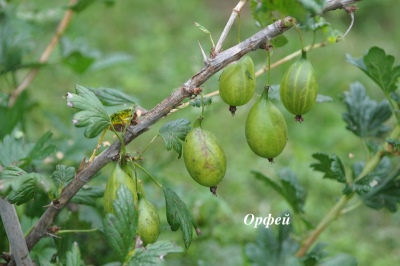
- Authors: E. Yu. Koveshnikova, K. D. Sergeeva (Michurin VNIIS)
- Growth type: medium-sized
- Description of the bush: medium spreading
- Escapes: growing - medium thickness, straight, light green; lignified - medium thickness, light
- Thorniness: below average
- Thorns: single, short and medium, medium, straight, light colored
- Sheet: five-lobed, small, green, slightly shiny, wrinkled, loose, concave
- Spike location: located perpendicular to the shoot and only in its lower part
- Flowers: bright
- Berry size: large
The gooseberry Orpheus is highly prized among gardeners. They often mention this winter-hardy variety in reviews. In addition to winter hardiness, the plant is also famous for its large-fruited and high yield. And it can be grown even in cold regions.
Description of the variety
Orpheus was brought out on the basis of the VNIIS enterprise named after V.I. Michurin by breeders Koveshnikova and Sergeeva. Medium spreading gooseberry bushes have an average type of growth, and their standard height is 0.7-0.8 m. Young shoots are straight, have a light green color, while older specimens are also light, their thickness is average.
The shoots are covered with leaves with 5 lobes, they are small in size. Leaves shine rather weakly, they are wrinkled, loose in structure. The shade is normal, green. Thorniness is also noted on the shoots. The thorns are straight by the type of growth, can be either short or medium. Painted in a light tone. They grow exclusively at the bottom of the shoots.
Orpheus has a two-flowered inflorescence. The flowers are quite bright and attractive.
Characteristics of berries
The described gooseberry yields a harvest in the form of large berries. They weigh from 4.8 to 7.1 g. The fruits are pear-shaped, but sometimes they are round-oval. Yellow-green gooseberry berries are covered with a skin without pubescence or with a light glandular type fluff. There are enough seeds inside the berries.
Taste qualities
Orpheus berries received a rather high assessment from experts - 4.8 points. The taste is sweet and sour, simple, but very pleasant. Berries contain a little sugar, so they are suitable for dietary meals. But there is more than enough ascorbic acid in them. Orpheus can be used for all types of culinary creations.
Ripening and fruiting
The ripening period for Orpheus is average. The culture belongs to the early-growing varieties.
Yield
The average share of the crop per bush is 3.6-4.2 kg. If we are talking about hectares, then from one such plot of land they collect from 12 to 14 tons.
Landing
You can plant the Orpheus variety in the sun or in light partial shade. The culture does not like strongly shaded areas. The soil should be selected for garden, light and loose, excess moisture is unacceptable. Plants are planted both in spring and autumn. Autumn planting is more recommended, about a month and a half before frost.
The dry roots of the seedlings are cut off before planting; the tops must also be shortened. It will be useful to soak the seed in a solution of sodium humate for 24 hours. The bush is placed in a dug hole at a slight angle, the earth will need to be carefully tamped. The distance between individual bushes should be approximately 1.5 meters.

Growing and care
Orpheus loves an abundance of oxygen, so it needs frequent loosening. To do this, use a small garden pitchfork, going deep into the soil by a maximum of 7 cm. During loosening, weeding is also carried out, clearing the soil from weeds.
Orpheus gooseberry is very fertile, so it quickly takes nutrients from the soil. To avoid a lack of them, the bushes should be fed. So, in early spring, the following fertilizers are given:
compost - half a bucket;
superphosphate - 50 grams;
ammonium sulfate - 25 grams;
potassium sulfate - 25 grams.
Top dressing is mixed with the soil in the near-trunk circle, and then the soil is loosened.
After flowering, the bushes will need a mullein. It must be diluted with water in a ratio of 1 to 5. Each bush must be given at least 5 liters of product. After 21 days, feeding is carried out again.
Orpheus is very important to cut correctly. For the first few years, they carry out shaping pruning. During it, the skeletal branches are shortened, and unnecessary shoots are removed, which the gooseberry gives abundantly. At 4 years old, diseased and weak branches, as well as those that have the wrong growth angle, begin to be cut. Old shoots that are more than 6 years old can also be removed, because they will no longer bear fruit.
Orpheus prefers moderate watering, but they must be carried out on time. Experienced gardeners recommend drip irrigation as the most effective. During the season, it is necessary to carry out at least 5 waterings, but under the condition of a dry summer, their number increases. The sprinkling method is unacceptable in the case of Orpheus.



Disease and pest resistance
Orpheus is excellent against American powdery mildew, fungal diseases and spotting. However, preventive treatments should not be ignored, as well as the stages of basic care.
Pests can infect gooseberries, usually a moth, a shoot aphid. A good preventive measure is to spill the bush with hot water in early spring. Another option that summer residents advise is to cover the soil under the bushes with roofing material. It is necessary to remove such a coating when the plants have already faded.

In order for the gooseberry to produce a good harvest, it is necessary to devote time to disease prevention.
Resistance to adverse climatic conditions
Orpheus withstands frost and drought with dignity. He is not afraid of the heat and the scorching sun. But this variety does not tolerate excess moisture. Too rainy and humid summers can lead to root rot.




































































